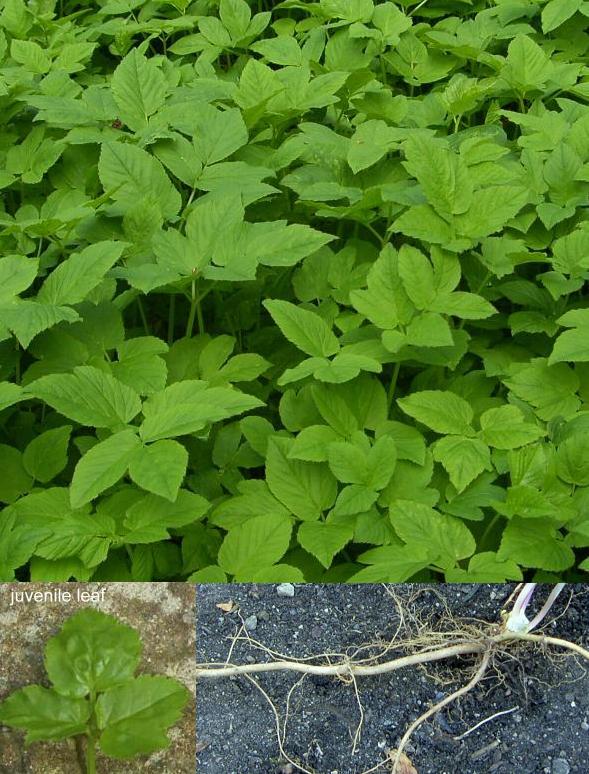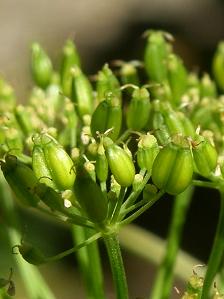Ground-elderScientific Name: Aegopodium podagraria |
Ground-elder is a perennial, spreading mainly by creeping underground stems, and by seed. Although
they have been found down to 30 feet or more in cave systems, the roots usually form a network just below
the surface, so they are quite easily dug up. However every last trace must be removed because any small
fragments will regenerate. This is why this weed is very difficult to eliminate as it is usually entangled among the roots of other plants or extending under paving. It is premature to declare victory in the battle with Ground-elder without allowing a
few years to pass. Vigilance is required for at least this amount of time for some re-emergence,
particularly if it has been allowed to grow unchallanged for some time and to produce seed. The roots will have been widespread
and the seed which will germinate as new plants.
It is a member of the Umbellifer
family so can act as an alternate host for the Carrot Fly Grub.
It was introduced to Britain from Continental Europe, possibly by the Romans, as a
pot-herb and a medicine against rheumatism and gout in the form of a poultice (hence one of the common names). Around the end of the first century monks started to include it in their herb gardens so its presence around ecclesiastical buildings gave rise a couple of the common names - Bishopweed and bishopwort.
The leaves are made up of several leaflets, each on a short stalk and the main the leaf stalks are triangular in section. They can be boiled like spinach (as they still are in Scandinavia, recipe below), or fresh young ones can be added to a salad - they have a pleasant, perfumey aftertaste. Use only young leaves before flowering as after this the old leaves have a powerful laxative effect. If growing for harvesting, cutting back will promote regrowth of fresh leaves. The dried root can be ground into a flour for baking.
In early summer upright, hairless stems develop; they have a grooved surface and can reach up to 100 cm, but are usually about half this. These carry the small white flowers which are are borne in umbels with 15 to 20 spokes.
A variegated variant is sold as an ornamental plant to be used as ground cover, but it should only be used where it can be isolated as it can become invasive, especially when it reverts to the natural green form.Dig out as much of the white to buff-coloured cylindrical roots as possible using a fork. This will
probably have to be repeated many times. It does not survive frequent mowing, so grassing over an
affected area for a few years might work, but usually the roots extend into hedgerows and can re-emerge, so it is difficult to eradicate by cultivation. Adjacent paving will also have a network of roots beneath it.
Be careful when accepting plants from another garden, as they can come with stowaways - if they have come
from an area known to have Ground-elder tease out the roots to see if others are present and remove
anything not attached to the plants. Affected plants can also be uprooted in the late autumn or early
spring when they are dormant to remove infesting roots. Shake off the soil or plunge the plant in a bucket of water to remove the
soil to reveal the unwanted roots, then replant immediately after removing the offending roots so that they do not dry out.
If the area is badly infested the plants can be replanted somewhere else or potted up temporarily, so that the weeds can be dealt with.
Invading roots coming from adjoining property can be blocked using a physical barrier buried to about 30 cm. After
digging treat any regrowth with a systemic herbicide or if very patient, weekly visits to remove any plants which emerge.
However this may take a long time and even after no regrowth for some months, a new plant can suddenly appear - possibly from seed. Any regrowth must be removed or treated immediately to exhaust the roots and prevent new ones from developing.
Never add the uprooted material to the compost heap, unless it has been allowed to dry out completely. Better to put in the recycling bin or it could be made into a liquid manure by immersing in water for a few weeks.
Companion planting with the annual Tagetes minuta (Muster-John-Henry) is said to inhibit growth so a barrier planting may slow the progress of the Ground-elder - this may just be the shading effect of the Tagetes as it can grow to 2 metres.
Glyphosate is a weedkiller which works by systemic action, so it is taken down into underground parts. Spray or paint on depending on the situation. Use when the plants are growing well and are moving their sap at a higher rate. The greater the area of leaf that can be treated the better and resist the temptation to remove any topgrowth for at least two weeks after application - do remove flower spikes.
Buttered Ground Elder
400g Ground elder leaves and young stems
90g butter
salt and black pepper, to taste
Add the leaves and shoots to about 30g of the butter and a little water in a pan with the seasoning. Cook gently while stirring for about 10 minutes or until just wilted. Drain and toss with the remaining butter before serving.
Ground Elder Soup
25 to 30 young stems of Ground Elder
25g butter
25g flour
a small onion chopped
a rasher of bacon cut into strips
500ml chicken or vegetable stock
250ml single cream
salt and pepper to taste
Remove the leaves from the stalks and wash before placing in the pan to be sweated for about a minute and leave aside. Fry the bacon and onion in the butter until the onion is softened, then add the flour. Add the stock slowly while stirring. Add the sweated leaves and simmer for about 5 minutes. Blend to form a smooth soup, season and stir in the cream before serving.
Nicholas Culpepper
(17th century astrologer-physician)
"Upon experiment it is found to heal the gout and sciatica. It is also used for aching joints and other cold pains."

Flowers in an umbel

Fruit